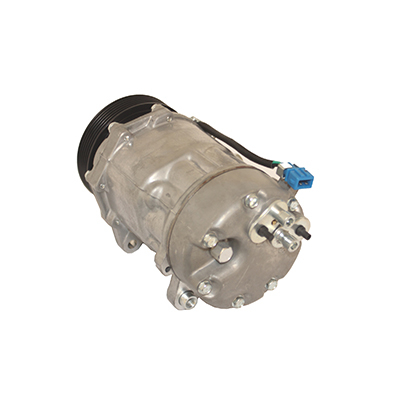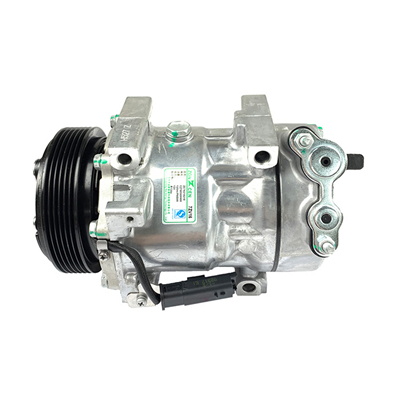
Optimizing Performance of Variable-displacement Wobble Plate Type Compressors in Passenger Cars
Unlock the secrets of variable-displacement compressors and their transformative impact on passenger cars. Dive into efficiency optimization, performance enhancement, and environmental sustainability with advanced compressor technology.
ZHONGCHENGIntroduction
In the ever-evolving landscape of automotive engineering, the pursuit of efficiency, performance, and environmental sustainability remains paramount. Among the myriad components influencing these factors, the air conditioning system stands out as a critical area for innovation. At the heart of this system lies the compressor, responsible for pressurizing the refrigerant and facilitating the cooling process. In this comprehensive exploration, we delve deep into the realm of variable-displacement wobble plate type compressors, elucidating their operational intricacies, optimization strategies, and transformative impact on passenger cars.
Operation Principles
Variable-displacement wobble plate type compressors epitomize versatility and efficiency in air conditioning systems. Central to their operation is the ingenious utilization of a wobble plate mechanism to modulate compressor displacement dynamically. As the engine rotates the swash plate, its eccentric motion imparts reciprocating movement to the pistons, compressing the refrigerant within the compressor cylinder. This pivotal mechanism allows for precise adjustment of compressor output, enabling seamless adaptation to fluctuating cooling demands within the vehicle cabin.

Key Components and Mechanisms
Swash Plate Dynamics
The swash plate serves as the linchpin of variable-displacement compressors, orchestrating the intricate dance of compressor operation. Driven by the engine, the swash plate undergoes controlled oscillations, dictating the stroke length of the pistons and thus regulating compressor displacement. This dynamic interplay between the swash plate and pistons forms the foundation of the compressor's adaptive capacity.
Piston Assembly Efficiency
Efficient piston assembly design is essential for optimizing compressor performance. The pistons, intricately linked to the swash plate, translate its rotational motion into linear compression, ensuring seamless refrigerant pressurization. Robust piston construction, coupled with precision engineering, minimizes frictional losses and maximizes energy transfer efficiency within the compressor cylinder.
Control Valve Precision
The control valve acts as the arbiter of compressor displacement, fine-tuning refrigerant flow to match cooling demands. By modulating the inclination angle of the swash plate, the control valve governs compressor output with surgical precision. Advanced valve designs, integrated with sophisticated control algorithms, facilitate seamless transition between various operating modes, optimizing compressor efficiency across a broad spectrum of conditions.
Optimization Strategies
Efficiency Maximization
Efficiency optimization lies at the crux of variable-displacement compressor design philosophy. By tailoring compressor output to real-time cooling requirements, these compressors minimize energy wastage associated with conventional fixed-displacement counterparts. Advanced optimization techniques, including variable valve timing and electronic control strategies, further enhance compressor efficiency, unlocking unprecedented gains in overall system performance.
Dynamic Control Algorithms
The advent of sophisticated control algorithms has revolutionized variable-displacement compressor optimization. Real-time data inputs, such as cabin temperature, ambient conditions, and engine load, are meticulously analyzed to orchestrate precise adjustments in compressor displacement. Machine learning algorithms, coupled with predictive modeling techniques, enable proactive adaptation to evolving driving scenarios, ensuring optimal cooling performance while minimizing energy consumption.
Refrigerant Management Innovations
Effective refrigerant management is critical for sustaining compressor efficiency and longevity. Proprietary refrigerant formulations, coupled with advanced lubrication systems, mitigate wear and tear on critical compressor components, prolonging service life and reducing maintenance costs. Additionally, innovations in refrigerant recycling and leakage detection technology further bolster environmental sustainability, aligning with industry-wide initiatives to reduce greenhouse gas emissions.
Thermal Regulation Solutions
Optimal thermal management is imperative for preserving compressor performance under diverse operating conditions. Innovative heat exchanger designs, coupled with intelligent thermal insulation materials, facilitate efficient heat dissipation and temperature regulation within the compressor assembly. Active cooling systems, augmented by variable-speed fans and coolant circulation mechanisms, mitigate thermal stress and ensure consistent compressor operation across the entire operating envelope.

Application in Passenger Cars
Fuel Economy Advancements
Variable-displacement wobble plate type compressors serve as linchpins in the pursuit of enhanced fuel efficiency in passenger cars. By minimizing parasitic losses associated with traditional fixed-displacement compressors, they unlock tangible gains in overall fuel economy. The seamless adaptation to varying cooling demands ensures optimal engine performance, translating into reduced fuel consumption and lower emissions output.
Comfort Optimization
Enhanced cabin comfort ranks among the primary benefits conferred by variable-displacement compressors. Precise temperature control, facilitated by dynamic compressor adjustment, ensures a consistently comfortable environment for passengers across diverse driving conditions. Reduced noise and vibration levels further augment the overall driving experience, fostering a tranquil and pleasurable journey for occupants.
Environmental Stewardship
The environmental ramifications of variable-displacement compressors extend far beyond the confines of individual vehicles. By minimizing energy consumption and greenhouse gas emissions, these compressors play a pivotal role in advancing sustainability initiatives within the automotive industry. From reducing carbon footprints to mitigating air pollution, their transformative impact resonates across the entire ecological spectrum, driving progress towards a cleaner and greener future.
Conclusion
In summation, variable-displacement wobble plate type compressors epitomize the pinnacle of technological innovation in automotive air conditioning systems. Their innate versatility, coupled with relentless optimization efforts, heralds a new era of efficiency, performance, and environmental sustainability in passenger cars. As the automotive landscape continues to evolve, these compressors stand poised to redefine the very essence of mobility, transcending conventional boundaries and forging a path towards a brighter, more sustainable future.
-
Innovative Applications of Fix-displacement Single-end Piston Wobble Type Compressors in Commercial Vehicles
 2024-05-16
2024-05-16
-
Exploring the Role of Variable-displacement Swash Plate Type Compressors in Enhancing Vehicle Efficiency
 2024-05-09
2024-05-09
-
Optimizing NEV Energy: Variable-displacement Compressors
 2024-04-30
2024-04-30
-
Routine Maintenance Tips for Auto Air Conditioning Compressor
 2024-04-22
2024-04-22






